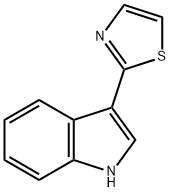135531-86-1
 135531-86-1 結(jié)構(gòu)式
135531-86-1 結(jié)構(gòu)式
基本信息
35531-86-1
化合物CAMALEXIN
Camalexine
Camalexin >=98% (HPLC)
3-(Thiazol-2-yl)-1H-indole
1H-Indole, 3-(2-thiazolyl)-
3-(1,3-Thiazol-2-yl)-1H-indole, camalexin
物理化學性質(zhì)
| 報價日期 | 產(chǎn)品編號 | 產(chǎn)品名稱 | CAS號 | 包裝 | 價格 |
| 2025/02/08 | HY-119502 | CAMALEXIN Camalexin | 135531-86-1 | 5mg | 700元 |
| 2025/02/08 | HY-119502 | CAMALEXIN Camalexin | 135531-86-1 | 10mM * 1mLin DMSO | 770元 |
| 2025/02/08 | HY-119502 | CAMALEXIN Camalexin | 135531-86-1 | 10mg | 1150元 |
常見問題列表
Reactive oxygen species (ROS)
Camalexin shows antiproliferative activity against a human breast cancer cell line.
For the oomycetes
Phytophthora
and
Pythium
Nep1-like proteins (necrosis and ethylene-inducing peptide 1-like proteins) are the initial triggers of Camalexin synthesis and formation of reactive oxygen species (ROS). ROS appear to be of general relevance for Camalexin formation. Chemical induction of ROS, such as by application of acifluorfen, coincided with Camalexin synthesis. In a screen for enhanced susceptibility to
Alternaria brassicicola
the
esa1
mutant is identified, which shows delayed Camalexin induction. Particularly in response to ROS inducing agents reduced Camalexin levels are synthesized. This crucial role for
ESA1
is confirmed by the inability of
esa1
mutants to synthesize Camalexin in response to
Leptosphaeria maculans
. An additional mutant that exhibits greatly reduced Camalexin accumulation is
ups1
, which is isolated on the basis of diminished expression of a tryptophan biosynthetic enzyme.
